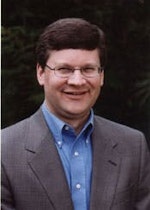Chris Stammen says his goal has never been to be one of the biggest shops — just one of the best. He launched Impact Auto Body as a one-man operation in Cincinnati in 1998. Today the company has five employees. Stammen says one key to competing successfully with larger shop operations was his decision to create an attractive, comfortable customer area in his shop.
“We have a little fireplace in the lobby and a big comfy couch, warm tone colors and nice artwork,” he says. “It’s such a simple, simple thing. But for years I walked into shops and other businesses where you didn’t get treated properly or the place was in disarray. A nice office and area for my customers makes them happy and comfortable, and it’s easier to form a relationship when they’re not worried about getting grease or dust all over themselves or getting bit by a dog. Our office remodel was really a turning point. My sales closing ratio went from about 60 percent to 80 percent almost overnight.”
Stammen’s experience is a good example of the surprising level of control smaller shops actually have over their own success in going up against larger competitors.
“You enjoy rapid adaptability,” Hank Nunn, president of H.W. Nunn and Associates and a popular instructor of management and marketing courses aimed at collision repairers, tells owners in a class aimed at smaller shop operations. “You can change to meet the market on a whim.”
Even more importantly, Nunn says, such shop owners can tell customers and those who may refer customers to you that you offer something no one else can — you.
“Tell that potential customer who comes into your shop, ‘One thing you get here that you don’t get anywhere else is my service and my attention,’” Nunn says. “‘You can go to the big shop down the street, where you’re just one of 150 cars in progress, or you can come here where you’re one of five or 10 or 15 and where I personally take care of you and your vehicle.’”
Focusing on attentiveness, speed of service and how much more important every single customer is gives the smaller shop a marketing advantage over larger competitors, Nunn says.
At a time in the industry when consolidation, insurer-owned shops and an increasing reliance on cost-savings driven by volume are among key trends, what’s the outlook for smaller collision repair operators? Are they likely to face the same fate as many corner pharmacies, neighborhood grocers and smaller hardware stores?
Here to stay
No way, says Mike West, whose seven-employee, 6,500-sq.-ft. shop has been on the same corner in the Seattle suburb of Tukwila, Wash., for more than 30 years. The business and building have expanded over that time, he says, but he believes shops of his size have a “tremendous advantage in today’s market.”
“You look at these mega shops or consolidators. We have distinct advantages over them,” West says of smaller shops. “Some people actually want to know the people who are repairing their car. Some people like that personal attention. When I go somewhere that I’ve been doing business for 30 years, it’s nice that they know my name when I walk in. We have customers like that. We trade on that fact. We created a niche market in our area.”
West’s wife Donna says it’s very unusual for one of them not to be at the shop every day when it’s open. They enjoy operating the business, she says, so they’re not interested in being absentee owners. That has become a selling point for them.
“Our customers come in and ask, ‘Where’s Donna?’ or ‘Where’s Mike?’” she says. “People come to us because they know we’re going to be there every day.”
Mike admits to being a bit of a stickler for detail and control, and can’t imagine trading places with the shop owner he knows with a huge shop and 19 employees in the office alone.
“He says he felt just like a victim waiting for the next chaotic situation to happen so he could react,” West says. “Trying to control that [size of shop] would be very difficult.”
He recalls having one of his long-time customers, the president of a local community college who along with West served on the board of the local chamber of commerce, tell the entire 25-member board what a great experience it was having her vehicle repaired at West’s shop.
“You can’t buy that kind of advertising. I don’t care what kind of money you spend,” West says. “That’s what you really want. Can the big mega-shop owner get that? Yeah, he can. Is it likely? Not as likely. I think you really have a big advantage by giving that personalized service. Even if a smaller shop isn’t always as profitable as a larger operation might be, there’s the great satisfaction of sitting in that Chamber of Commerce meeting and having that customer say, ‘I am pleased with this shop.’”
West agrees with those who say success as a smaller operation may require developing a niche.
“I never really used to understand what that meant,” West says. “I thought it meant focusing on one type of car or a certain part of the market. But for smaller shops, it can mean you’re creating a niche market of people who like that personal attention.”
Marketing and convenience are key
John and Mary Dickerson are another husband-wife team who see a bright future for smaller shops in the industry. The second-generation owners of Dickerson’s Collision Repair in Garland, Texas, say marketing, customer service and convenience are the three things that can help almost any size shop compete with “the big boys.”
“One of the main factors that will influence where a customer will take their business is convenience,” Mary Dickerson says. “No one wants to drive a long way out of the way. I know for me, I want something that’s close to where I live or work.”
In many areas, it can be tougher for a larger shop to locate closest to where a large population of people live and work, she says.
Like Mike and Donna West, the Dickersons also see “an attitude of indifference by employees” in many larger businesses in many industries. Again, that can give an advantage to the small business operator willing and able to provide courteous, personal attention.
Marketing is only going to become even more critical to the survival of smaller shops, the Dickersons believe. But without the marketing budgets of larger shops, smaller shops have to be smarter about how they market themselves.
“I think it’s important when planning your marketing strategy that you know as much about your competition as possible,” says Mary Dickerson, who holds a degree in business. “Learn all you can. What are their operating hours? Are they open on Saturday? A lot of people are so busy during the week that they don’t have time to handle car repairs. I know just being in my office on Saturday mornings has brought in many jobs that our competition — larger and smaller — missed out on simply because they are not open on Saturday mornings.”
Like many larger shops, the Dickersons knew it was worthwhile to call regularly on insurance agents, mechanical shops and others who could refer them work. They tried hiring a full-time salesperson, but found that wasn’t cost-effective. But with only the two of them in the shop’s office, it can be tough to have one of them away.
“So now on the mornings when I go out and make sales calls, I’ll have a temporary come in and work for me while I’m out,” Mary Dickerson says.
Networks and new profit centers can help
One way some smaller shop operations are trying to bring more revenue to their door and more profit to the bottom line is by offering more services. Towing and mechanical services, spray-on truck bedliners and paintless dent repair are certainly among the most common added services collision shops offer.
But there are some less common options that may work in your market. James Boitnott, owner of Boitnott’s Custom Body, Paint & Accessories in Fairfield, Ohio, has capitalized on American’s love of accessorizing their vehicles; one study found that nearly two-fifths of all U.S. households (39.5 percent) purchased at least one aftermarket accessory for their vehicle in 2004.
“We started selling accessories about six years ago when we moved into this building because it was designed around having a storefront,” Boitnott says. “It’s worked well. We can usually up-sell a job a little. The other thing is that a lot of the body shops around us aren’t set up for it, so we can help get them parts that they need and cut them some good prices to help the people we know in the industry. It’s definitely been worth it.”
Charlie James, owner of Lebanon Auto Body in Lebanon, Ore., has also offered vinyl sign creation and installation on vehicles for several years.
“Since I don’t do any of the collision repair work on vehicles myself, the vinyl signs are something I can do during my slow times in the office as another source of income,” he says.
He’s also partnered with a national glass firm to make his shop a glass installation location.
Most owners of smaller shops say banding together with other shops is another way they are able to compete with larger players in the industry. Other smaller shops join “20 groups” to share ideas and compare their shop’s performance with similar sized shops in other markets. They join the local and national trade associations to get industry information and discounts on products and services.
Some have found it helpful to join one or more of the shop networks or franchises; James, for example, became a NAPA AutoCare Collision Center. These networks vary widely in terms of fees and services, but most promise some combination of marketing benefits, discounts on products and services, and training.
Successful operators of smaller shops caution that no one added service or network is a cure-all or a guarantee for success, but if chosen carefully, they may give shops an edge on larger competitors.
Rare — but not endangered
With the continued growth of mega-shops, local and regional consolidators and multi-location collision repair businesses, smaller shops are likely to face even tougher competition in the future. But there will always be a place, Mike West and others believe, for smart operators of shops of every size who focus on quality work, personalized service and continuous improvement and marketing of their businesses.
“When people come in to get their car fixed, they like to be recognized, they like the attention, they like the fact that they think you’re the one who is working on the car and fixing it yourself and checking it out,” West says. “You should capitalize on that for all you can, because it’s getting to be rarer and rarer.”




